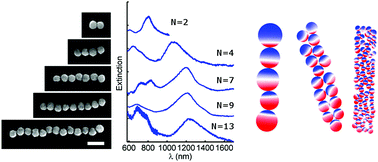Plasmonic polymers unraveled through single particle spectroscopy†
Abstract
Plasmonic polymers are quasi one-dimensional assemblies of nanoparticles whose optical responses are governed by near-field coupling of localized surface plasmons. Through single particle extinction spectroscopy correlated with electron microscopy, we reveal the effect of the composition of the repeat unit, the chain length, and extent of disorder on the energies, intensities, and line shapes of the collective resonances of individual plasmonic polymers constructed from three different sizes of gold nanoparticles. Our combined experimental and theoretical analysis focuses on the superradiant plasmon mode, which results from the most attractive interactions along the nanoparticle chain and yields the lowest energy resonance in the spectrum. This superradiant mode redshifts with increasing chain length until an infinite chain limit, where additional increases in chain length cause negligible change in the energy of the superradiant mode. We find that, among plasmonic polymers of equal width comprising nanoparticles with different sizes, the onset of the infinite chain limit and its associated energy are dictated by the number of repeat units and not the overall length of the polymer. The intensities and linewidths of the superradiant mode relative to higher energy resonances, however, differ as the size and number of nanoparticles are varied in the plasmonic polymers studied here. These findings provide general guidelines for engineering the energies, intensities, and line shapes of the collective optical response of plasmonic polymers constructed from nanoparticles with sizes ranging from a few tens to one hundred nanometers.


 Please wait while we load your content...
Please wait while we load your content...